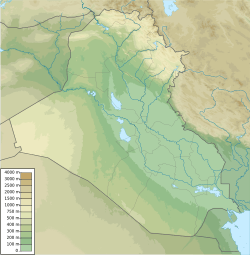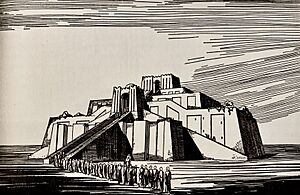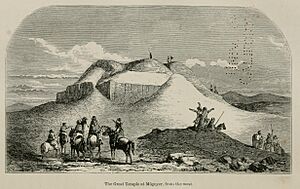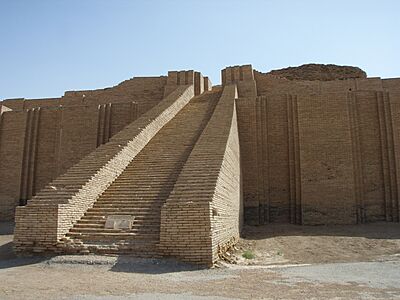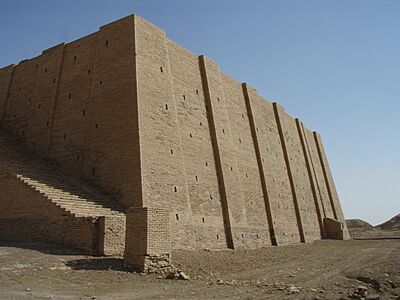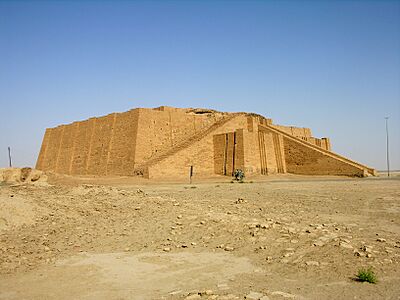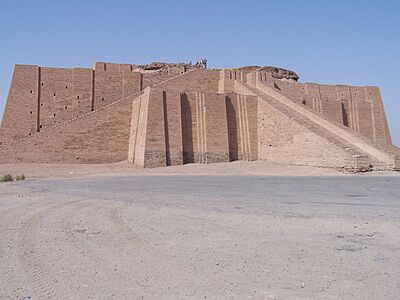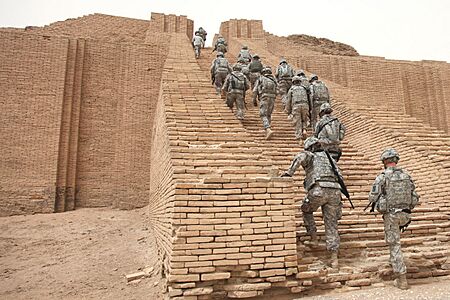Ziggurat of Ur facts for kids
|
Etemenniguru
|
|
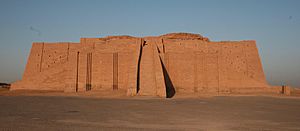
Partially reconstructed facade and the access staircase of the ziggurat. The actual remains of the Neo-Babylonian structure can be seen at the top.
|
|
| Alternative name | Great Ziggurat of Ur |
|---|---|
| Location | Tell el-Muqayyar, Dhi Qar Province, Iraq |
| Region | Mesopotamia |
| Coordinates | 30°57′46″N 46°6′11″E / 30.96278°N 46.10306°E |
| Type | Temple |
| Part of | Ur |
| Area | 2880 m2 |
| Height | over 30 m |
| History | |
| Builder | Ur-Nammu |
| Material | mud brick with burnt brick facing |
| Founded | started in c. 2050–2030 BC, completed in c. 2030–1980 BC |
The Ziggurat of Ur is a huge, ancient temple structure. It is located in what was once the city of Ur. This city was in Mesopotamia, which is now Iraq.
A ziggurat is a type of pyramid-shaped temple. This one was built by the Sumerian people. It was made thousands of years ago, around 2050-2030 BC. The ziggurat was dedicated to Nanna, the moon god. It was a very important religious and administrative center.
Over time, the ziggurat fell into ruins. But it was partly rebuilt in the 6th century BC. This was done by King Nabonidus. Today, the Ziggurat of Ur is one of the best-preserved ziggurats. It helps us understand ancient Mesopotamian life.
What is the Ziggurat of Ur?
The Ziggurat of Ur is a massive, stepped pyramid. It was built by King Ur-Nammu. He built it to honor the moon god Nanna/Sîn. This was around the 21st century BC. The original structure was very large. It was about 64 meters long and 45 meters wide. Its height was likely over 30 meters. However, only the lower parts of the original ziggurat remain today.
This ziggurat was part of a larger temple complex. This complex was the main administrative center for Ur. It was also a sacred place for the city's patron god, Nanna.
The building of the ziggurat was finished by King Shulgi. He was Ur-Nammu's son. Shulgi ruled for 48 years. During his time, Ur became a very powerful capital city. It controlled much of ancient Mesopotamia.
Discovering and Protecting the Ziggurat
The remains of the ziggurat were first found in 1850. This discovery was made by William Loftus. The first digging at the site happened in the 1850s. This work helped identify the location as the ancient city of Ur.
Later, after World War I, more digging took place. Sir Leonard Woolley led large excavations. He worked there from 1922 to 1934. His team uncovered much of what we know today.
The ziggurat was built with mud bricks. These bricks were covered with burnt bricks. The burnt bricks were held together with bitumen. Bitumen is a natural tar-like substance. The lowest part of the ziggurat is the original structure. The two upper parts were added later. These were part of the Neo-Babylonian restoration.
In the 1980s, parts of the ziggurat were rebuilt. This was done under the orders of Saddam Hussein. The front of the lowest level was restored. The grand staircase was also rebuilt.
Sadly, the rebuilt ziggurat was damaged in 1991. This happened during the Gulf War. It was hit by small arms fire. Explosions also shook the structure. There are still bullet holes and bomb craters nearby.
Today, the site is carefully looked after. It remains an important historical place.
Gallery
See also
- Abraham
- Nasiriyah Airport
- Abraham and the temple in Islamic tradition
- Ennigaldi-Nanna's museum
- Architecture of Mesopotamia
- Ur of the Chaldees
- Ziggurat of Aqar Quf


